
Recent Posts
Artwork #2: Monopoly: Aftermath
Monopoly: Aftermath
Game Mechanics:
- Free Parking -> Parking Tax $150
- Income Tax -> Increase pay to $400
- Luxury Tax -> Increase pay to $200
- Go To Jail -> Go To Just Visiting
- All “pay” cards are doubled (chance/community)
- Going to jail card takes you to Just Visitng instead
Fun Fact:
- The total cost to buy and upgrade everything to max is $14,850
- The total amount of money per Monopoly game is $20,580
Game Setup:
Do math: 20,580 – 14,850 = 5,730
- 2-players -> 2,865 per player
- 3-players -> 1,910 per player
- 4-players -> 1,432 per player
- 5-players -> 1,146 per player
Rules:
- Regular Monopoly Rules except…
- Everything is always fully graded and bought
- Last player standing wins
Other ways to play:
Players agree on how much money they wanna start with and try to outlast each other.
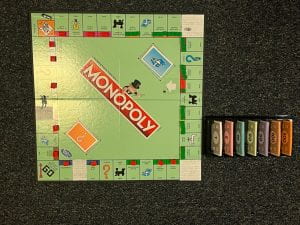
Time to not go broke
Artist Statement:
When thinking of a game to create, I had my eyes set on Monopoly. The first concept of the game was called “The Landlord’s Game” created by Elizabeth Maggie. Her intention was to expose how property owners profit from impoverishing renters. I wanted to use that idea but modernize it, creating a game where you can “win” but come to the realization that you will never truly beat the game. In Monopoly: Aftermath, you start the game with all the properties already being bought and fully upgraded (hence the “aftermath” in the title). You are given some money to go around the board and try to be the last man standing. I decided to also change some of the spaces and rules. All the tax spaces are doubled in cost, Free Parking now charges you, all chance and community chest cards that say pay are now doubled, and you can no longer go to jail(the idea is that you are not worth the police’s time since you are too poor to be significant). While I also wanted to edit the cards, I unfortunately had no time to do so. My reason for these changes is to highlight the state of our economic system where people aren’t able to buy property, cost of living has increased unlike our paychecks, and it’s only a matter of time before everything seemingly leads to you becoming bankrupt. After going through my two playtests, players loved the satirical aspect of how realistic. In the readings there was anti-war art, specifically in the Berlin chapter with John Heartfield and George Grosz who created art to not only express their feelings about the war but to also convey the detrimental effects of it. I wanted to create an anti-property owner game like Maggie did. I also had players suggest themes for this concept in actual places like Los Angeles, Boston, San Francisco, etc. But why not let someone else come up with that idea? In the spirit of DADA, I would love it if someone would appropriate my game and/or come up with a different interpretation with my game as inspiration.
DADA Collage :NEW YORK CITY

Chess D&D
Summary:
My project appropriates chess and D&D by combining the two, where three players and a DM play out a game of Chess involving role-playing and other D&D mechanics that are far too complex for chess. Three players will each receive character sheets (Pawn, Knight, and Bishop), with various attributes crudely changed to fit Chess closer. The game’s ‘map’ will be a standard chess board (a parody of the maps used in typical D&D) that the players will be able to see and make their movements using the board as intended.
Rules:
Like standard DND, there is an out-of-combat and in-combat phase. Out of combat, players may move freely and interact with any NPCs they would like. In this phase, squares on the board represent an area of 5×5 feet in the game world. All pieces have a ‘viewing range’ of 1 square around them. If you speak or do something outside this range, unless you attempt to make it widely visible, that action will be unseen by all pieces not within a 3×3 grid around you. Additionally, while out of combat up to 3 pieces may share a single square.
When a combat encounter begins, players roll for initiate and take turns in typical DND fashion. On their turn, players can take combat actions like standard 5e (move and/or attack), however moving is special in that during combat, players are restricted to moving only how their piece is able to move in a game of chess. Other than this, the rules are identical to 5e.
Scenario:
The opposing black and white kingdoms are on the verge of war. Three players assume the roles of three white pieces as they attempt to end the conflict one way or the other. Black pawns are on the move, and all looks grim. However, maybe violence is not the answer, and there is a peaceful resolution to this after all?
DM ONLY: (Players will only be able to see the board and know their starting positions. I used this board as well as the corresponding graph to keep track of characters and who was who.)

- Player 1 (Pawn)
- Player 2 (Knight)
- Player 3 (Bishop)
- —
- Nervous White Pawn 1
-
-
- Very nervous about the war and secretly doesn’t want to fight.
-
- Nervous White Pawn 2
-
-
- Very nervous about the war and secretly doesn’t want to fight.
-
- Neutral White Pawn 1
-
-
- Nervous, but loyal and wants to do their duty.
-
- Neutral White Pawn 2
-
-
- Nervous, but loyal and wants to do their duty.
-
- Neutral White Pawn 3
-
-
- Nervous, but loyal and wants to do their duty.
-
- Neutral White Pawn 4
-
-
- Nervous, but loyal and wants to do their duty.
-
- Nervous White Pawn 3
-
-
- Very nervous about the war and secretly doesn’t want to fight.
-
- Loyal Rook 1
-
-
- Fiercely loyal to the King and won’t stand for any treason or slight towards the king.
-
- White King
-
-
- Very prideful and unwilling to admit that there is any other way than violence. Sees any disrespect to his flawed thinking as treasonous.
-
- White Queen
-
- Secretly a pacifist, but wants to support the king despite his flaws. Might be convinced that violence isn’t the answer if given a good enough alternate plan.
Etc…
Example Character Stats:
- Pawn (underappreciated footsoldier)
-
- Movement: 1 Space Forward*
- Alignment: Lawful Good
- Health: 8
- AC: 11
- Attributes:
- Strength: 14 (+2)
- Dexterity: 12 (+1)
- Constitution: 14 (+2)
- Intelligence: 10 (0)
- Wisdom: 10 (0)
- Charisma: 10 (0)
- Skill Modifiers:
- Athletics (+4)
- History (+2)
- Insight (+2)
- Survival (+2)
- Attacks:
- Capture (uses STR/DEX), 1d6 + 2 damage. [Must be 1 space diagonally to the left or right of the pawn.]
- Abilities/Spells:
- *Haste (on your first turn in combat, you may move 2 spaces forward instead of one.)
- Rook (experienced mercenary)
- Movement: Unlimited spaces orthogonally (unless blocked)
- Alignment: Lawful Neutral
- Health: 18
- AC: 14
- Attributes:
- Strength: 16 (+3)
- Dexterity: 10 (0)
- Constitution: 14 (+2)
- Intelligence: 10 (0)
- Wisdom: 12 (+1)
- Charisma: 10 (0)
- Skill Modifiers:
- Athletics (+5)
- Insight (+3)
- Intimidation (+2)
- Religion (+2)
- Attacks:
- Capture (uses STR/DEX), 2d6 damage. [Must be along the movement path. Goes to target to perform attack.]
- Abilities/Spells: (3 spell slots)
Etc…
Artists Statement:
Seeing the many examples of appropriating existing video games to create new experiences shown in class, I knew that I wanted to create a game that embodied the absurd nature of some of these games- ‘PacManhatten’ and ‘Out Run’ come to mind. Particularly, the idea of creating a game that combined two existing games that had nothing to do with each other seemed like a great opportunity to make a comical and original project. Drawing inspiration from ‘DMPacMan,’ I similarly wanted to find two games that seemed completely incompatible on paper and come up with a hybrid- and thus the idea for Chess D&D was born. Just as PacMan and Unreal Tournament contrast each other so starkly, the idea of the in-depth combat and role-playing of Dungeons & Dragons being used to frame a simple game of chess seemed like a properly absurd idea.
In playtesting, I found that players responded well to even the basic absurdity of the idea from the start, which led to more fun attempting to work within such an outlandish and silly premise for a D&D campaign. I’m happy with the overall player experience, however, I do feel that the board itself, while a novelty to use in the context of a D&D map as intended, makes the free-form interaction with the world that D&D normally offers significantly more difficult. It was a challenge in all my playtests to decide on how players were allowed to move outside of combat given that I wanted to balance actual playability while maintaining the fact that they were chess pieces that could only move how they were able to move in a standard game of Chess. It also might have helped the experience overall if I had a true chess board, but as I didn’t own one I had to make an imitation board with paper.
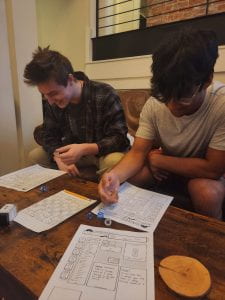
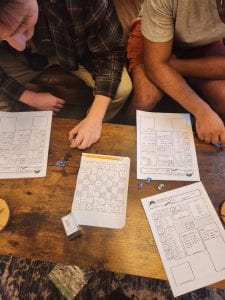

“Find the Fire Emblem” – Samik Mathur
How to Play:
- The game needs 2 people, one person plays as “Ike” or the Player, and the other plays as “Ashera” or the DM
- Ashera must place the board in front of Ike and place all the information and items face-down
- Lastly, Ashera shows the player the card that says that they are Ike
- Then the game starts
- Only Ashera can see the location of items and ensures that Ike is following the rules presented on the card
- Ike wins the game if he obtains Lehran’s Medallion
Artist’s Statement:
For this project, I had 2 initial goals: appropriate from Fire Emblem and make a game that is open-ended. I wanted to appropriate from Fire Emblem because I was heavily inspired by the series when coming up with the basic premise of the game. I had the idea to make a game where the player has a set amount of actions they can perform before they die so that every time they had a new life they were a little better off than before. Unlike a roguelike, I wanted to make the benefit of another life something more immaterial. With that, I settled on making lives useful because you would have more information about your surroundings. This is where the inspiration from Fire Emblem (specifically Fire Emblem: Path of Radiance) came into play. I could appropriate the grid-based movement system to make the player’s life equate to a number of steps, I could use famous items from the game to serve as tools to get you to your ultimate goal, and I could use lore from the series to contextualize your adventure. Lastly, I wanted to make sure that the players’ approach to the game was open-ended. This was inspired by the Dada Movement and from games like Super Metroid that emphasized trying new things and not explaining a lot. I wanted the player to interpret the board and realize what was happening on their own, so I did not give much information to the player.
This work relates to the Dada Movement for a few reasons. The first reason is that I used images from another artist and used them in a constructive way for my game. Dada artists often took images from other places and used them in collages, especially in cities like Hannover. Another way this relates to the Dada Movement is that I used lore or a story from another place to influence my work. The reading Dada artists in Cologne were often inspired by Christianity when making their works. My game took the story of Fire Emblem: Path of Radiance and adapted it. Lastly, I built my game to be open-ended and ordinary-looking. The game is made with simple paper and the only materials you need are your mind and the paper (though a pencil helps). The way the game is played is also very open-ended because there is nothing saying what you should do on a life, only an end goal and 1 restriction. This is similar to how Dada artists like Duchamp took ordinary objects like a chair and bicycle and transformed them into an open-ended piece of art.
Documentation:
- Game being Played
- Item & Information Sheets
- Documentation of Puzzle Solution:
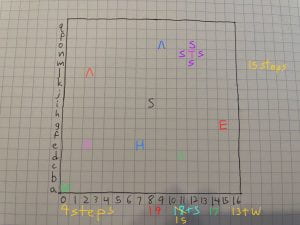
Paris

Dada Collage: Hannover
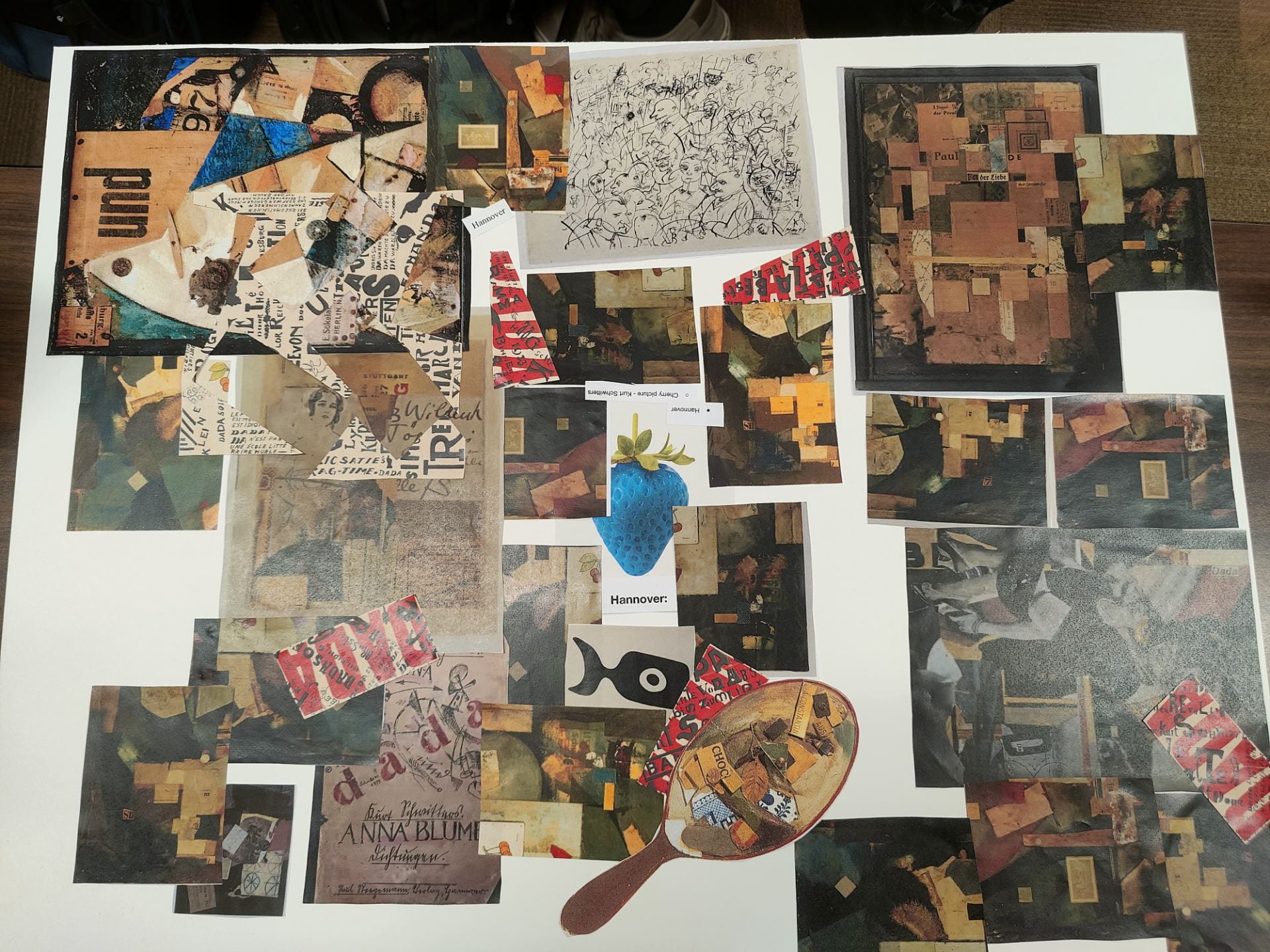
Dada Collage: Cologne

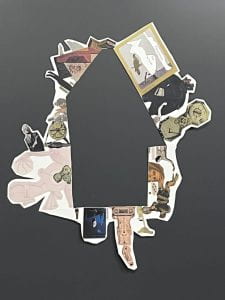
Berlin Dada Head Collage
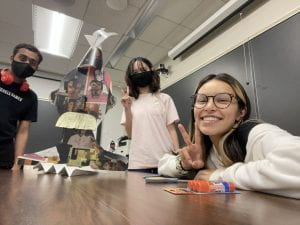
Dada Collages Fall 2023
Each student was asked to bring one image from each of the six cities in Dada: Zurich, Berlin, Hannover, Cologne, New York, Paris by Leah Dickerman. Students then got into teams and created six collages, one representing the ethos of the dada community in each city. Here are the results!

Score: Making a game that isn’t fun
By Luca Sandoval
This is a game. It’s supposed to be fun. Here’s what you need to play it:
- A deck of face-down rule cards (provided.)
- A large handful of coins (not provided, obviously.)
The rules are very simple.
- There are two players. They each take turns flipping a coin, calling heads or tails before it lands.
- The person who guesses correctly gets a point.
- The first to one thousand points wins.
If at any point during the game you decide you aren’t having fun, feel free to draw the top card from the pile of rule cards. This should help make the game more fun.
————————————————————————————————-
(This section is not a part of the score.)
The rule cards provided are small pieces of paper that have the following messages, in order:
- New rule: Correctly calling the coin is now worth 10 points, but if you get it wrong, you lose a point instead.
- New rule: Each player can recruit another player as their additional team member. Those two players also flip a coin, and the points they either win or lose belong to the team.
- New rule: Each team should recruit three more players. At this point, it’s probably worth establishing some kind of team organizational structure. The original player is the ‘team captain,’ of course, but you should ask the new hires how they feel about that. They may choose to assist your cause, or not, I suppose.
- New rule: Add all of the coins you have left to the game. Coins are now valuable, maybe even more valuable than points (that isn’t currently clear). After all, at the end of the day, you have to put food on the table and keep the lights on, and points aren’t going to pay those bills. As a secondary requirement for victory besides reaching one thousand points, your team should also ensure they are financially better off than the other team by the end of the game.
- New rule: The team members have unionized. Team captains should have seen this coming. They all demand to be paid a fair wage in coins and won’t keep playing until those demands are met. As a new requirement for victory on top of the old ones, negotiate a fair contract with the team members.
- New rule: There’s been an economic recession. Everybody is hit hard, none more so than the innocent coin-flipping industry. Inflation has skyrocketed and coins and now next to worthless. You can sell back your team’s coins to the bank for fifty points each, which seems like an okay deal. However, as a consequence of the recession, the new requirement for winning is one hundred thousand points.
- New rule: There’s really no point in playing games anymore given the state of the economy.
Reflection:
My score was largely inspired by some of the works we saw relating to chess, and how artists in this movement would create twists on games that made them nearly impossible to play- and in the process allowed for the players to find their own fun using a broken ruleset. One that came to mind for my design was Yoko Ono’s White Chess Set, which featured an entirely white chessboard. This seems to make the game impossible to play, but in playing it I imagined that it might be its own sort of fun to attempt to remember which pieces were your own, or maybe just forgo the original rules altogether and simply play around with the broken ruleset. My score attempts to capture this energy by starting with a simple ruleset and slowly adding mechanics that derail it more and more until players are forced to find their own fun in the chaos. I also wanted the playing experience to be funny over anything else, thus the increasing absurdity of the rules.
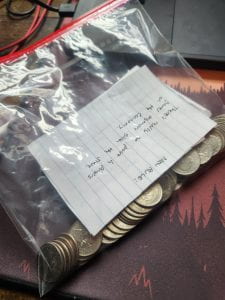
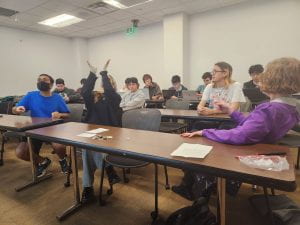
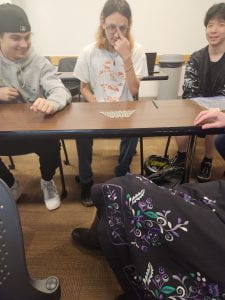

I was able to test my score two separate times, so it went through several revisions before the final. I was happy with the humor element of the score, as I feel in both cases the absurdity of the rules led to players creating comical situations, such as ‘firing’ their team leader or stealing/hoarding all the coins for their team. I do think that this score could be a bit more open-ended than the version I provided, and while I like the idea of the scenarios I’m providing for players (as a vehicle to create further comedy), it might be worth exploring a version of the game with less specific steps and punchlines while still maintaining the spirit of the score.